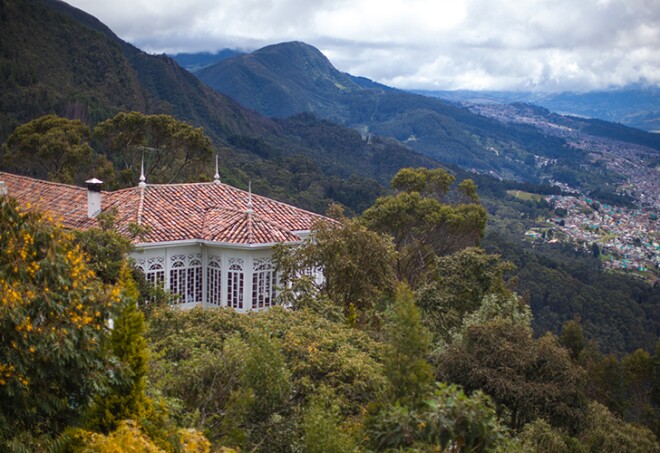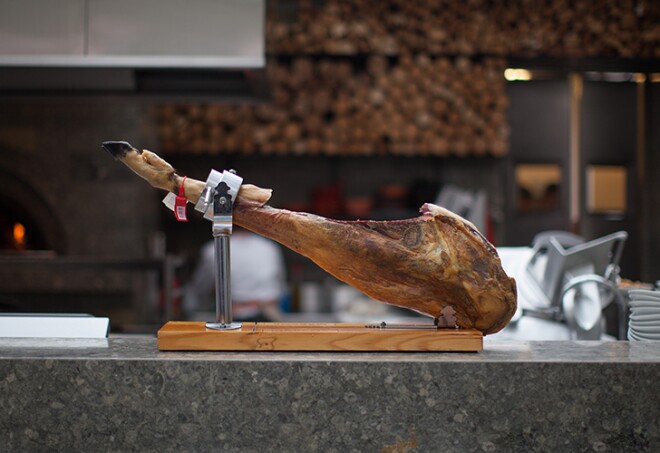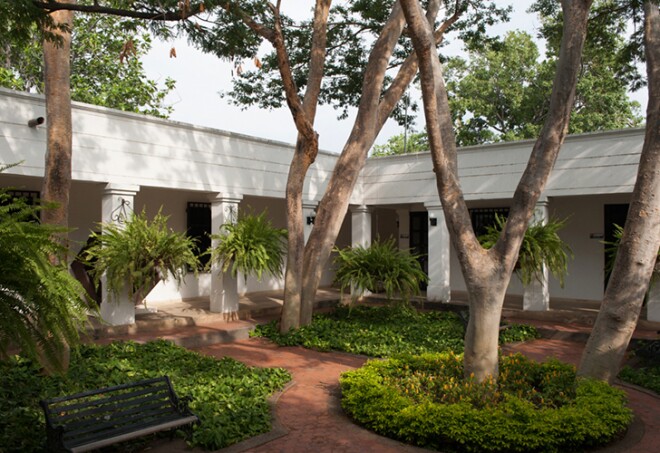The Perfect Week in Colombia
Ok, so maybe you’ll need a week and a half. Perhaps even two? Stay a month. There’s more than enough to do on this trip from Bogotá to Medellin and then along the coast of the Caribbean Sea from Cartagena to a National Park or the Lost City. Explore vibrant cities and relaxed seaside towns. Hike. Take a cable car from neighborhood to neighborhood. Eat. Dance. Drink. And plan your return.
Monserrate Bogotá, Colombia
The peak called Monserrate towers over central Bogotá and lends its name to the church that tops it. Perched more than 10,000 feet above sea level, the sanctuary—dedicated to the Passion of Christ—has beautiful gardens showcasing marvelous highland vegetation, and the city views from here are spectacular (sunsets are especially recommended). Ascend Monserrate by cable car, via railway, or on foot (this last is only for the fittest and those already acclimated to the altitude). That beautiful white house on the mountainside is Casa Santa Clara restaurant, a better-than-expected, special-occasion-suitable venue at which to try traditional Bogotá favorites like ajiaco, a thick potato-and-chicken soup.
Carrera 6 No.15-88, Bogota 110321, Colombia
Bogotá’s museum of all things gold is one of Colombia’s greatest treasures. Yet despite the name, you’ll find more here than just the precious metal. In addition to stunning displays drawing on a collection of more than 30,000 gold treasures, you’ll find highlights from the institution’s more than 20,000 artifacts of clay, textiles, and other materials that reveal the history of Colombia’s diverse pre-Hispanic cultures. Audio guides enhance the experience with information on the objects’ purpose and provenance that connects various periods and movements. The museum shop offers dazzling (if somewhat expensive) souvenirs fashioned by members of Colombia’s many indigenous nations.
Cl. 11 #4-41, Bogotá, Colombia
Set within the Banco de la República’s museum complex, the Botero Museum offers a sampling of paintings and sculptures by famed Colombian artist Fernando Botero, best known for his still lifes and his exaggeratedly rotund human figures. Botero donated 123 of his own pieces to the institution, as well as 85 from his personal collection—including treasures by Chagall, Picasso, Monet, and Miró. The gracious colonial-era mansion includes an area that displays contemporary Latin American and European artworks. Audio guides are available in English, French, and Spanish.
Parque De La Sal, Zipaquirá, Cundinamarca, Colombia
About an hour north of Bogotá lies the so-called Salt Cathedral, an intriguing and impressive church that has been sculpted from the empty chambers of a working salt mine, one that’s been in operation since pre-Hispanic times. Beginning in the 20th century, miners began to decorate shafts with icons and saints from whom they sought protection. By 1954, a full-fledged cathedral had been carved into the rock and inaugurated; it has been attracting visitors from all over the world ever since. When a previous sanctuary became unstable, the current chapel was carved almost 200 feet deeper down and opened in 1995, complete with eerie lighting and beautiful sculptures. A visit is a moving experience even for nonbelievers.
Cra. 9 #75-70, Bogotá, Colombia
Chef Harry Sasson is nothing short of an institution in Colombia’s culinary realm, one of the people responsible for having reactivated a local interest in haute cuisine. Mixed-grill aficionados will thrill equally to his langoustines (with mushrooms and cashews in a sweet-and-sour sauce) as they will in the sweetbreads (done in parsley, garlic, and oregano). But you’ve also got the perennial house-smoked grouper, or duck that’s cooked twice to make sure every piece achieves just the right consistency. A great wine list and a merry mood overall make any dinner at this historic residence on Carrera 9 a memorable one.
Calle 69a # 5-75, Zona G, Bogotá, Colombia
Once a quiet residential neighborhood near Bogotá’s financial district, Zona G (as in gourmet) is now an all-city dining hot spot that’s abuzz day and night, serving everything from upscale burgers (at Gordo) and pizzas (at Julia) to fine dining (at Criterión) and great brunches. The area outpost of Juan Valdez Café is Bogotá’s loveliest and liveliest. Zona G sprawls over several blocks surrounding the intersections of Calle 70 and Carrera 5.
Cl. 73 #51d-14, Medellín, Antioquia, Colombia
Medellín’s botanical garden is a 35-acre oasis of green amid the bustling city. Stroll through lush tropical vegetation, towering trees, and flowering bushes to a quiet, picturesque pond amid the gardens. Or peek into a butterfly farm, a maze, and an orchid exhibit beneath an arbor. The gardens are a public space for all sorts of activities like yoga, martial-arts classes, and outdoor movie screenings; a farmers’ market for organic goods takes place the first Sunday of every month. The park is also home to one of Medellín’s best restaurants, In Situ, which in addition to its normal gourmet fare sells lunchtime picnic baskets—complete with red-and-white-checkered blankets and a bottle of wine—to enjoy on the garden grounds.
Carabobo, Medellín, Antioquia, Colombia
At the center of Medellín, Plaza Botero gets its name from Colombian artist Fernando Botero, who donated 23 of his much-loved, disproportionate-bodied bronze sculptures to the city. There’s a huge chubby head, a reclining woman, and an oddly small man with a bowler hat riding a horse, plus good old Adam and Eve. The Museo de Antioquia abuts the plaza and houses other pieces by Botero as well as works by other artists. By day the square is vibrant and lively, but do take appropriate precautions after dark.
Medellín’s urban renewal, following decades as one of the world’s murder capitals, has drawn international attention. Perhaps nothing symbolizes the revival more than the Metrocable, a system of cable cars that connect the city center to steep hillside neighborhoods that were once reckoned to be the city’s most dangerous. Grab a ride on Line K up to Santo Domingo and treat yourself to spectacular views. Once on the ground again, take a short wander around the neighborhood for a taste of the real Medellín and its friendly residents (known as Paisas), and see the small shops and the beautiful library whose original benefactor was the government of Spain. From Santo Domingo, another cable car continues to Parque Arví, an expansive nature reserve and weekend escape favored by overheated locals.
Cl. 10 #25-18, Medellín, Antioquia, Colombia
The Parque Lleras neighborhood is the throbbing heart of Medellín nightlife. The namesake park is tiny, but its surrounding blocks are packed with bars, restaurants, and clubs, many featuring terraces. Wherever you choose to go, it’s usually a high-energy, loud affair with thumping music and fruity cocktails. The area is ground zero for Medellín’s young, hip partyers, out to be seen; weekend dancing rarely ends before sunup.
Parque Bicentenario, Cl. 51 #36-66, Medellín, Antioquia, Colombia
This sobering museum reminds visitors that Colombia’s beauty, natural and otherwise, has often coexisted with civil war and its brutal violence. Galleries present stories and images as well as survivor, victim, and ex-combatant testimonies. Many artists have contributed portrayals of the war—but perhaps the experience with the strongest emotional impact at the museum is simply watching the videos in which victims of the violence tell their stories.
Cra. 53 #7375, Medellín, Antioquia, Colombia
The four huge red cubes set amid the verdant mountains around Medellín will seize your attention and pique your curiosity—they are pavilions that architect Alejandro Echeverri designed to house Parque Explora, a science museum that is rather a monumental toy itself. The goal was to strike a proper balance between wonder and learning—and to avoid at all costs the sort of place that quickly grows obsolete. The result offers a nice sort of carnival or market feeling in its wide-open spaces. Inside, the pavilions, aquarium, planetarium, and cool science and tech exhibits keep both wee ones and grown-ups entertained and awed.
Carrera 40 # 10A-22, Medellín, El Poblado, Colombia
Whether you are celebrating a special occasion or just for a spontaneous night of indulgence: Medellin is blessed with romantic dining spots. El Cielo, just opposite Parque Lleras, is as well-known throughout Latin America as its creator Juan Manuel Barrientos—a young chef synonymous with creating unforgettable experimental cuisine. Dishes are separated into ‘moments’ and are all created by his team of chefs and designers in his food lab. Diners can choose from either 10 or 15 ‘moments.’ Each dish has a lifespan of three months, after which it is replaced by a new, vastly different dish. Meanwhile Carmen, located a few blocks away, offers not only high-end, diverse cuisine but also a seductive interior and some extraordinary cocktails.
The spirit of the late Gabriel García Márquez—one of Colombia’s most beloved cultural figures, and certainly its most beloved writer—lives on in Colombia, and is felt palpably in Cartagena. Though the Nobel Prize–winning author lived in Mexico City for many years, he had a home in Cartagena, and it was one of the cities that inspired his novels and the magical-realist style in which they were written. A walking tour focuses on the city’s influence on the work of Gabo (to use his affectionate nickname), with a smart narrative recounting historical, cultural and literary references.
Cl. del Colegio #34-24, Cartagena, Bolívar, Colombia
The interior spaces as well as the incredible rooftop at an amazing former mansion in Cartagena’s historic center are the setting for the Colombian Caribbean’s most talented bartenders. The cocktails mixed here are magic potions that transform whiskey, vodka, gin, and rum into can’t-miss elixirs, always with a local lilt. The crowd—sophisticated locals and hip turistas looking for a break from pure tropicalismo—love the DJs who come here to spin jazz, funk, and hip-hop.
Av Carlos Escallon 34-01, Centro Histórico, Cartagena, Bolívar, Colombia
The 19th-century residence that houses this restaurant by chef Juan Felipe Camacho presents a subtle maritime vibe. The gustatory offering highlights a little bit of everything, but seafood and local shellfish—in generous portions—are the stars of an unpretentious international menu that’s anchored by a celebrated dish of sautéed snapper in coconut-shrimp sauce. Also available: exquisite carnivore dishes like grilled beef shoulder with blood sausage and piquillo peppers.
la No. 36 44, Universidad de Cartagena, Cartagena, Bolívar, Colombia
Occupying three whitewashed colonial buildings sheltered from the bustling streets of Old Town Cartagena, Casa San Agustín sits on the site of a former aqueduct and channels its heritage with a swimming pool that tunnels through its stately remnants. Inside, common spaces feature a mix of Colombian art and artifacts with contemporary wicker furnishings and marble floors. The 20 rooms and 10 suites are cozy and a bit more polished than those found at other historic properties nearby: Units feature 200-year-old wood-beamed ceilings and iron canopy beds topped with Frette linens; some have patios with hot tubs or brick terraces with views of surrounding buildings. But there’s plenty of space to unwind throughout the property, namely a library with original frescoes and a lounge with a long wooden bar and ceiling-high wine cabinet. It’s a good idea to make reservations in advance for dinner at Alma, considered among the city’s best restaurants, where the upscale international cuisine includes fresh ceviche and dry-aged beef cured on-site.
3-86 Calle 36
In a city that inspired the most famous works by the winner of a Nobel Prize in literature, you’d be forgiven for expecting a place to buy novels on every corner. Cartagena’s book offerings are somewhat slim, but the best by far is Ábaco, a bookstore and café in the heart of the old part of the city. It draws local literati, but even if you don’t speak Spanish, you’ll find something here; there’s a small gift section, and, of course, Colombian coffee.
Cra. 60 #6838, Barranquilla, Atlántico, Colombia
Barranquilla’s must-go eatery for exceptional, local, and home-style specialties prepares its meals using organic, locally sourced produce only. In a warmly decorated, landmark colonial residence, Donde Mamá serves up a Colombian delicacy often found on the country’s Caribbean coast—the traditional mote de queso, yam soup with chunks of floating cheese and bits of pork rind.
46 - 66 Calle 36
Colombians from the Caribbean coast, known as Costeños, are immensely proud of their cultural, musical, literary, and historical heritage, all of which are on display at this interactive museum. The country’s famous shore stretches from the jungles bordering Panama up through the historic cities of Cartagena, Barranquilla, and Santa Marta, all the way to the deserts of La Guajira. Multimedia exhibits here offer insight into the region’s indigenous cultures, and into the varied musical expressions that have emerged along the long coastline.
Cra. 54 ##70-10, Barranquilla, Atlántico, Colombia
El Prado, a grand hotel that stands as a testimony to Barranquilla’s golden days as Colombia’s gateway to the world, is now on the nation’s registry of historic places. When it opened in 1930, it boasted of being the first luxury lodging in Colombia, with private bathrooms and telephones in every room. Narcotraficante interests acquired the property in the 1980s and made it an operations center, which drove away legitimate guests. But after government seizure and decades of decline, things are once again on the upswing. Don’t miss the expansive pool and its shady vegetation, especially when the mercury soars (day passes are available). And afternoon aperitifs or lunches beneath these palms are always a welcome respite.
Carrera 44 #72-263, Barranquilla, Atlántico, Colombia
Barranquilla’s famed pre-Lenten carnival is the supreme forum for residents’ festive spirits, but that same dance-till-you-drop energy can be found all year round at La Troja, now in its 52nd year. The barroom is a no-frills, open-air affair—weekend crowds regularly spill onto the streets in a veritable salsa-dancing tempest (definitely go elsewhere if you want quiet drinks and conversation). The music invites you to dance—with your honey, with the people at the next table, even the staff—so loosen up and enjoy.
Cra. 43 #59-03, Barranquilla, Atlántico, Colombia
Founded in 1954, La Cueva, in the seaside town of Barranquilla, gained renown as a favorite watering hole of some of Colombia’s most famous artists, writers, and intellectuals, most notably the so-called Barranquilla Group—which included Gabriel García Márquez—and painter Enrique Grau. All-night affairs were said to be equal parts pontification and house party, with a dollop of boogie. Today’s La Cueva serves a varied menu and invites visitors to relive the bohemian spirit of the artists who put this place on the map (some of their faces adorn a portrait that takes up an entire wall). Jazz bands play here on Wednesdays and Thursdays.
Av. del Libertador - Sector San Pedro Alejandrino, Santa Marta, Magdalena, Colombia
The 17th-century estate where Simón Bolívar died in 1830 is the site of several Bolivar monuments as well as an art museum featuring works by Latin American artists inspired by Bolívar, the hero who freed Bolivia, Colombia, Ecuador, Panama, Peru, and Venezuela from colonial rule. The estate serves as the city’s botanical garden, also worth your time for its magnificent, centuries-old trees.
One of the best ways to see Santa Marta is on the waterfront promenade, the Paseo El Camellón (also known as the Paseo de Bastidas), which runs between the city’s old port and the new marina. The palm tree–lined walk has several plazas where you can stop and take in the view, which is especially stunning at sunset. The walk is also a popular location for vendors selling crafts and sweets made from coconut and tropical fruits. Sculptures along the promenade depict the indigenous people of the region, providing a link to the area’s history.
Cra. 3 #19-29, Santa Marta, Magdalena, Colombia
Centrally located on Parque de los Novios, Ouzo serves the city’s best Mediterranean dishes, including brick oven pizzas, seared octopus and roasted lamb with orzo. The chef and owner, Michael McMurdo, began his culinary career in New York City at the Michelin-starred Greek restaurant Anthos. On a visit to Colombia, however, he was charmed by Santa Marta and decided to make his home in the city, opening Ouzo in 2011. The result is a celebrated Greek restaurant in an unexpected corner of the Caribbean.
Magdalena, Colombia
Tayrona National Natural Park has become such a popular destination during typical vacation periods that authorities have had to limit admission. But an off-season visit offers singular luxuries like miles of all-but-solitary beaches, jungle trails, and a unique way to observe a variety of monkeys and tropical birds in every brilliant hue. Tayrona can be experienced as a day trip from Santa Marta or as a several-night stay at one of the park’s accommodations. From the main entrance at Cañaveral (El Zaíno), visitors can take a leisurely hike to the ocean while a donkey handles the luggage; horses are also available for those who prefer not to walk. This same park entrance also leads directly to high-roofed, native-wood cabins known as ecohabs, a slightly fancier option for staying in the park.
Calle 15 #5 - 63, Santa Marta, Magdalena, Colombia
Ciudad Perdida (or “lost city”) is believed to have been a political and spiritual center for the people that inhabited the Sierra Nevada de Santa Marta highlands around 800 C.E. Treasure hunters “discovered” the complex in the 1970s and plundered its ceremonial artifacts. The subsequent arrival of archaeologists and anthropologists failed to turn up the site’s true origins with any certainty, but indigenous Arhuaco and Kogui people believe it was a sacred city. It seems to have been abandoned around the same time the Spaniards arrived. Today’s visitors can still see a network of 169 terraces carved into the mountainside, overlooking the Buritaca River. The city can be experienced two different ways—choose to hike in (a four-to-six-day guided trip) or to fly over on a helicopter tour (though note that aircraft are not permitted to land).





































